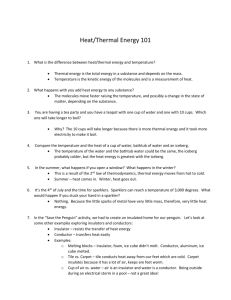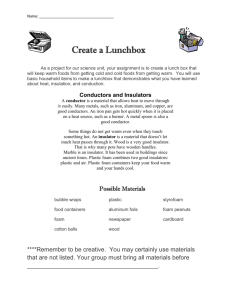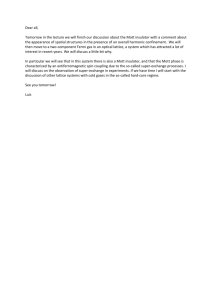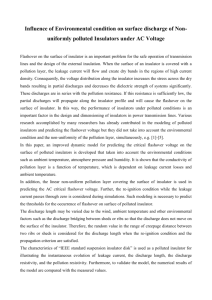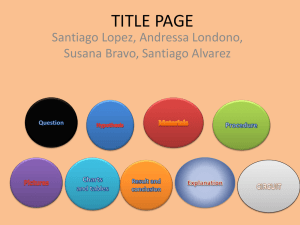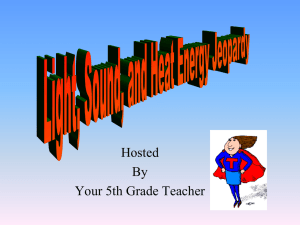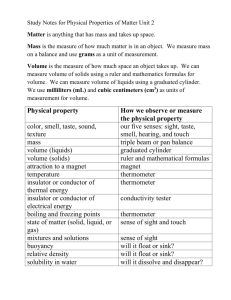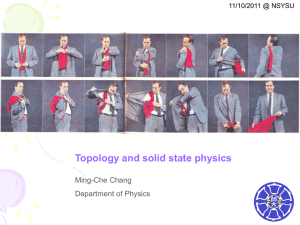g02_Q3_L5_eTRG
advertisement
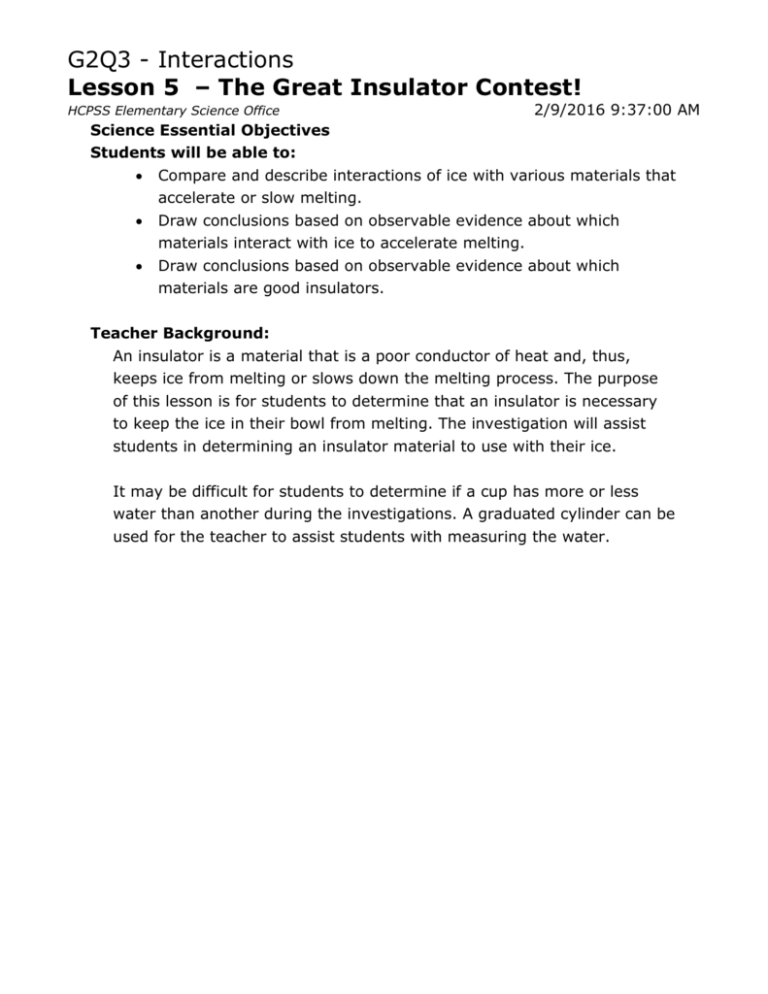
G2Q3 - Interactions Lesson 5 – The Great Insulator Contest! HCPSS Elementary Science Office 2/9/2016 9:37:00 AM Science Essential Objectives Students will be able to: Compare and describe interactions of ice with various materials that accelerate or slow melting. Draw conclusions based on observable evidence about which materials interact with ice to accelerate melting. Draw conclusions based on observable evidence about which materials are good insulators. Teacher Background: An insulator is a material that is a poor conductor of heat and, thus, keeps ice from melting or slows down the melting process. The purpose of this lesson is for students to determine that an insulator is necessary to keep the ice in their bowl from melting. The investigation will assist students in determining an insulator material to use with their ice. It may be difficult for students to determine if a cup has more or less water than another during the investigations. A graduated cylinder can be used for the teacher to assist students with measuring the water. G2Q3 - Interactions Lesson 5 – The Great Insulator Contest! HCPSS Elementary Science Office Teacher Preparation: This lesson will take two days to compete. Have six ice cubes for each group of four students readily accessible so they do not melt before they are needed. Display the unit problem and the “Know-Need-to-Know-Learned” (KWL) charts. Copy, cut and laminate insulator cards, TRG p. 29-36. Obtain cold water from a cold water fountain or refrigerator. Tear up two Styrofoam cups for each group of four students and put in a plastic bag. For each group of four students, label six 3.5 oz. cups with one of each of the following: cold water, paper, cotton, foil, Styrofoam, and plastic wrap. Prepare a tray for each group of four students with six labeled 3.5 oz. cups, six 20 oz. cups, 30 cotton balls, one 8” x 12” piece of plastic wrap, one 8” x 12” piece of foil, 10 oz. cold water, one sheet of 8 ½ “ x 11” piece of paper, and two Styrofoam cups. Put students in groups of four for the exploration and in groups of two for the extension. Materials Needed For: Provided in the KIT: Teacher Consumables To be ordered from Science Resource Center Located in your SCHOOL One 10 mL graduated cylinder Group of 4 or 5 Students Six 20 oz. cups Six 3.5 oz. cups 30 cotton balls Six ice cubes the same size One sheet of 8 ½ “ x 11” paper Ten ounces of Pair of Students 8” x 12” piece of foil 8” x 12” cold water piece of plastic wrap Two torn up 8 oz. Styrofoam cups 1. Hot and Cold by Karen Bryant-Mole Individual Students 2. Pencils G2Q3 - Interactions Lesson 5 – The Great Insulator Contest! HCPSS Elementary Science Office Engagement – Day One 1. Invite students to the discussion area and distribute Hot and Cold by Karen Bryant-Mole. 2. Invite students to partner read or use a read aloud strategy to read pages 18-19. 3. Discuss the following questions: What could Jonathan put his soup in if he did not want it to cool down? (thermos) If a thermos keeps things hot, what could you use to keep cold things cold? (A cooler. Note: Some students may realize that a good thermos will keep things cool.) 4. Tell students that thermoses and coolers are called insulators which keep cold things cold and hot things hot. Write the word insulator on the chalkboard. 5. Share with students that today they will be investigating different materials to see if they are effective insulators so that they can design a cooler to keep ice from melting at the iced tea booth. 6. Have student cut out their prediction cards and glue them in the order they predict the ice cubes will melt (least effective insulator to most effective insulator). 7. Distribute Student Resource Packets and have students turn to SRP pp 13, “Insulation Investigation,” and discuss the following: What is our purpose for reading to perform a task? (read all directions first, perform directions in order, look at diagrams, collect materials before beginning) What are some strategies that the author used to make the directions easy for readers to understand? (title, diagrams, subtitles, numbered steps, and materials list) 8. Use a guided reading or read aloud strategy to read all the directions together. 9. Distribute trays of materials. 10. Direct students to set up the investigation by following the directions on SRP pp 1-3. 11. Have students place all materials on a science tray and save for Day Two. Exploration – Day Two 1. Distribute Student Response Booklets and have students cut out result cards on SRB p. 10. These cards should be placed on their desks for later use. 2. Distribute science trays from Day One and ice cubes. 3. Share with students that they will be placing one equal-sized ice cube in each cup at the same time. Ask students why this is important. (Everything must be in the cup at the same time in the investigation except for the insulator material so that it is a well-designed investigation.) 4. Direct students to place the ice cubes in all six cups at the same time. 5. Wait 15 minutes. During this time, have students come to the discussion area. For each pair of students, distribute one of the insulator picture cards. 6. Invite students to discuss with their partners whether or not the item in their picture would eve need to be insulated. 7. Display the thermos on the chalkboard and ask who has a picture of something that could be insulated by a thermos. Place the pictures of coffee and soup under the thermos. Discuss why the coffee and soup need to be insulated. 8. Repeat step 12 for the coat (students and man), freezer (ice cream and popsicle), and attic insulation (house and school). 9. Have students who have not placed a picture on the chalkboard, lace the remaining pictures in a separate area of the chalkboard. (clock, pencil, radio, and shoe) 10. Discuss with students why these remaining pictures do not need to be insulated. 11. After 15 minutes, direct students to return to their investigation areas and remove the small cups from the insulators. 12. Direct students to observe the cups and order the cups from least effective insulator (most melted ice) to the most effective insulator (least melted ice). 13. Direct students to order their results cards in the same order as the ups and glue them on SRB p. 9. Explanation: 1. Invite students to the discussion area with their Student Response Booklets. 2. Ask students to share their results as the teacher manipulates the teacher EPR cards on the chalkboard. 3. Discuss the following questions using TPS: Can you tell in your own words what you did today with the ice cubes? How do your predictions compare to your results? Did any of the results surprise you? How do you know that ___ is the most effective insulator? How do you know that ___ is the least effect insulator? Why are the results from each group similar, but not exactly the same? Why do you think this information might be important for people to know in their everyday life? (keep food cold, keep themselves warm, keep home cool) 4. Display the KWL chart and record student ideas about what they have learned from this lesson in the “Learned” column. Also record any further “Need-to-Know” questions. Extension – Day Three 1. Direct students to open their Student Response Booklet to SRB p. 11, “Designing Your Own Cooler.” 2. Use guided reading strategy to read the directions with students. 3. Direct students to look at the different materials found in the garage at the top of the page and guide them to make connections to the materials that were used in the investigation (metal bowl – foil, cardboard box – paper, plastic cup – plastic wrap, Styrofoam peanuts- Styrofoam cup, cotton shirt – cotton balls). 4. Direct students to draw their design for a homemade cooler with labels. 5. Set an appropriate time limit. 6. When appropriate time has passed, put students into pairs and have them describe their designs to their partners and receive feedback. 7. Invite students to the discussion area and display a sheet of chart paper. 8. Read the directions for the caption and have students brainstorm stems for their sentences. (My cooler is made by ___. I chose these materials because __. From the investigation, I learned __.. 9. Direct students to return to their desks and write a caption for their design. (Optional Language Arts/Home Connection) Read The Mitten by Jan Brett**. Have students measure the temperature of their hands with and without mittens (see TRG p. 39-41) and discuss clothing as an insulator. This activity could be used as a home investigation. (Students can write to Jan Brett at Post Office Box 366 Norwell, Massachusetts 02061. She will write back and send a packet of activities about her books. (Optional Language Arts Connection) Read Mama, Do You Love Me? by Barbara Joosse*** or Eskimo Boy by Russ Kendall**** and discuss examples of warm clothing worn by the Inuit characters in the story. Students could also make a cut out figure of an Eskimo, dress him or her, draw an appropriate setting and write about clothing as an insulator. Evaluation: 1. SRB p. 9, “The Great Insulator Contest” 2. SRB p. 11, “Designing Your Own Cooler” 3. Students’ oral responses *Bryant-Mole, Karen. Hot and Cold. Des Plaines: Heinemann, 1998. **Brett, Jan. The Mitten. New York: Putnam Publishing, 1996. ***Joosse, Barbara. Mama, Do You Love Me? San Franscisco: Chronicle Books, 1998. ****Kendall, Russ. Eskimo Boy. New York: Scholastic. G2Q3 - Interactions Lesson 5 – The Great Insulator Contest! HCPSS Elementary Science Office G2Q3 - Interactions Lesson 5 – The Great Insulator Contest! HCPSS Elementary Science Office The Great Insulator Contest! Student predictions will vary. results may vary slightly Cold Water Insulator Paper Insulator Plastic Insulator Cotton Insulator Foil Insulator Styrofoam Insulator G2Q3 - Interactions Lesson 5 – The Great Insulator Contest! HCPSS Elementary Science Office Designing Your Own Cooler These are the materials you and your parents found around the house that can be used to insulate ice. Metal Bowl T-Shirt Styrofoam Peanuts Cardboard Box 1. Circle one or more materials that you would use to design your own cooler. 2. Draw your cooler design in the box. Be sure to label each part. Water Other designs are acceptable if supported adequately box Styrofoam Answers will vary but should include • materials used • summary of what student learned about effective insulators • connection of results of investigation to choice of material 3. Write a caption on the lines above explaining your diagram and why you chose these materials. Be sure to use evidence from the insulator investigation to support your ideas. G2Q3 - Interactions Lesson 5 – The Great Insulator Contest! HCPSS Elementary Science Office 9. Are mittens insulators? Give support from the investigation. ____________________________________________________ ____________________________________________________ ____________________________________________________ ____________________________________________________ ____________________________________________________ ____________________________________________________ ____________________________________________________ ____________________________________________________ ____________________________________________________ ____________________________________________________ ____________________________________________________ ____________________________________________________ ____________________________________________________ ______________________________________ G2Q3 - Interactions Lesson 5 – The Great Insulator Contest! HCPSS Elementary Science Office Optional Parent Letter for “Are Mittens an Insulator? Home Investigation Optional Dear Parent/Guardian, Our science class has been studying some interactions of matter. The students are using ice cubes, tea bags, and other materials to identify interactions. They have also learned how to use insulators to slow an interaction, such as ice melting. The students are being encouraged to complete the attached home investigation to extend their knowledge about insulators. Students may need some parental assistance to complete the activity. We hope you enjoy participating in the excitement of your child’s discoveries! Scientifically yours, __________________
